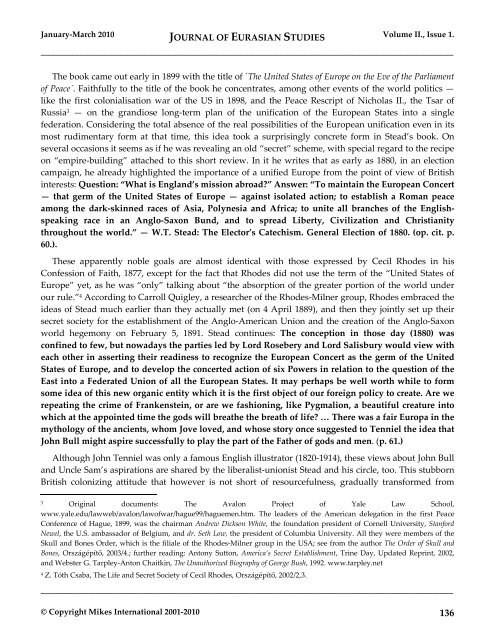EurasianStudies_0110..
EurasianStudies_0110..
EurasianStudies_0110..
You also want an ePaper? Increase the reach of your titles
YUMPU automatically turns print PDFs into web optimized ePapers that Google loves.
January-March 2010 JOURNAL OF EURASIAN STUDIES Volume II., Issue 1.<br />
_____________________________________________________________________________________<br />
The book came out early in 1899 with the title of ´The United States of Europe on the Eve of the Parliament<br />
of Peace´. Faithfully to the title of the book he concentrates, among other events of the world politics —<br />
like the first colonialisation war of the US in 1898, and the Peace Rescript of Nicholas II., the Tsar of<br />
Russia 3 — on the grandiose long-term plan of the unification of the European States into a single<br />
federation. Considering the total absence of the real possibilities of the European unification even in its<br />
most rudimentary form at that time, this idea took a surprisingly concrete form in Stead’s book. On<br />
several occasions it seems as if he was revealing an old “secret” scheme, with special regard to the recipe<br />
on “empire-building” attached to this short review. In it he writes that as early as 1880, in an election<br />
campaign, he already highlighted the importance of a unified Europe from the point of view of British<br />
interests: Question: “What is England’s mission abroad?” Answer: “To maintain the European Concert<br />
— that germ of the United States of Europe — against isolated action; to establish a Roman peace<br />
among the dark-skinned races of Asia, Polynesia and Africa; to unite all branches of the Englishspeaking<br />
race in an Anglo-Saxon Bund, and to spread Liberty, Civilization and Christianity<br />
throughout the world.” — W.T. Stead: The Elector’s Catechism. General Election of 1880. (op. cit. p.<br />
60.).<br />
These apparently noble goals are almost identical with those expressed by Cecil Rhodes in his<br />
Confession of Faith, 1877, except for the fact that Rhodes did not use the term of the “United States of<br />
Europe” yet, as he was “only” talking about “the absorption of the greater portion of the world under<br />
our rule.” 4 According to Carroll Quigley, a researcher of the Rhodes-Milner group, Rhodes embraced the<br />
ideas of Stead much earlier than they actually met (on 4 April 1889), and then they jointly set up their<br />
secret society for the establishment of the Anglo-American Union and the creation of the Anglo-Saxon<br />
world hegemony on February 5, 1891. Stead continues: The conception in those day (1880) was<br />
confined to few, but nowadays the parties led by Lord Rosebery and Lord Salisbury would view with<br />
each other in asserting their readiness to recognize the European Concert as the germ of the United<br />
States of Europe, and to develop the concerted action of six Powers in relation to the question of the<br />
East into a Federated Union of all the European States. It may perhaps be well worth while to form<br />
some idea of this new organic entity which it is the first object of our foreign policy to create. Are we<br />
repeating the crime of Frankenstein, or are we fashioning, like Pygmalion, a beautiful creature into<br />
which at the appointed time the gods will breathe the breath of life? … There was a fair Europa in the<br />
mythology of the ancients, whom Jove loved, and whose story once suggested to Tenniel the idea that<br />
John Bull might aspire successfully to play the part of the Father of gods and men. (p. 61.)<br />
Although John Tenniel was only a famous English illustrator (1820-1914), these views about John Bull<br />
and Uncle Sam’s aspirations are shared by the liberalist-unionist Stead and his circle, too. This stubborn<br />
British colonizing attitude that however is not short of resourcefulness, gradually transformed from<br />
3 Original documents: The Avalon Project of Yale Law School,<br />
www.yale.edu/lawweb/avalon/lawofwar/hague99/haguemen.htm. The leaders of the American delegation in the first Peace<br />
Conference of Hague, 1899, was the chairman Andrew Dickson White, the foundation president of Cornell University, Stanford<br />
Newel, the U.S. ambassador of Belgium, and dr. Seth Low, the president of Columbia University. All they were members of the<br />
Skull and Bones Order, which is the filiale of the Rhodes-Milner group in the USA; see from the author The Order of Skull and<br />
Bones, Országépítő, 2003/4.; further reading: Antony Sutton, America’s Secret Establishment, Trine Day, Updated Reprint, 2002,<br />
and Webster G. Tarpley-Anton Chaitkin, The Unauthorized Biography of George Bush, 1992. www.tarpley.net<br />
4 Z. Tóth Csaba, The Life and Secret Society of Cecil Rhodes, Országépítő, 2002/2,3.<br />
_____________________________________________________________________________________<br />
© Copyright Mikes International 2001-2010 136

















